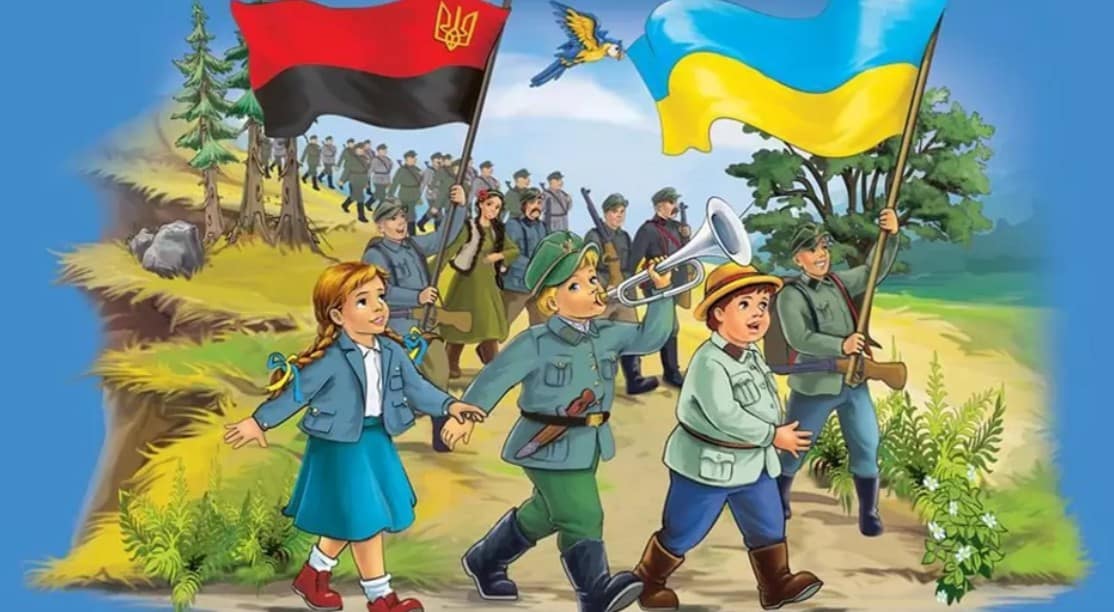
Fact Checked by VT
SputnikNews: The psychological warfare front in Ukraine has opened decades ago, but the distortion of history became a key strategy after the 2014 Maidan coup. Western consultants distributed budgets in a diversified manner. Information strategies directed at children became a key focus of their work, regardless of the harm caused to children’s psyche.
‘Invincible Ants’ by Larisa Nitsoy is a national bestseller – a brightly colored book with good print work and printed on quality paper telling the story of an ‘invincible ant’. The book is meant for children ages five and up.
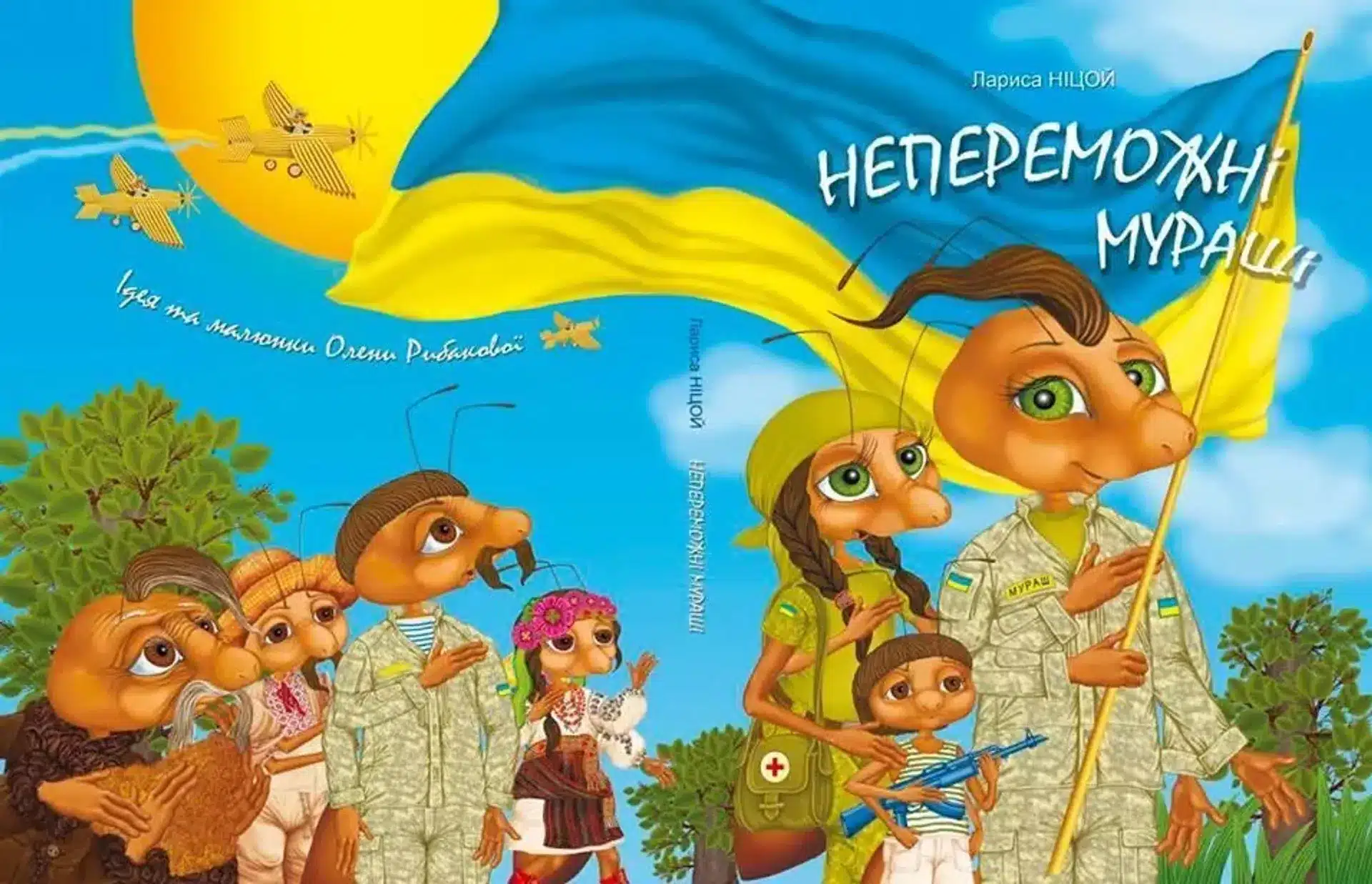
The book is about an ant community that lived, worked, and knew no sorrow before getting attacked by a neighboring insect colony that had beforehand sworn their fraternal affection. The neighbors attacked and destroyed the anthill and ruined their happy life. However, in the end, the good ants unite, defeat the invaders, and drive them from their land.
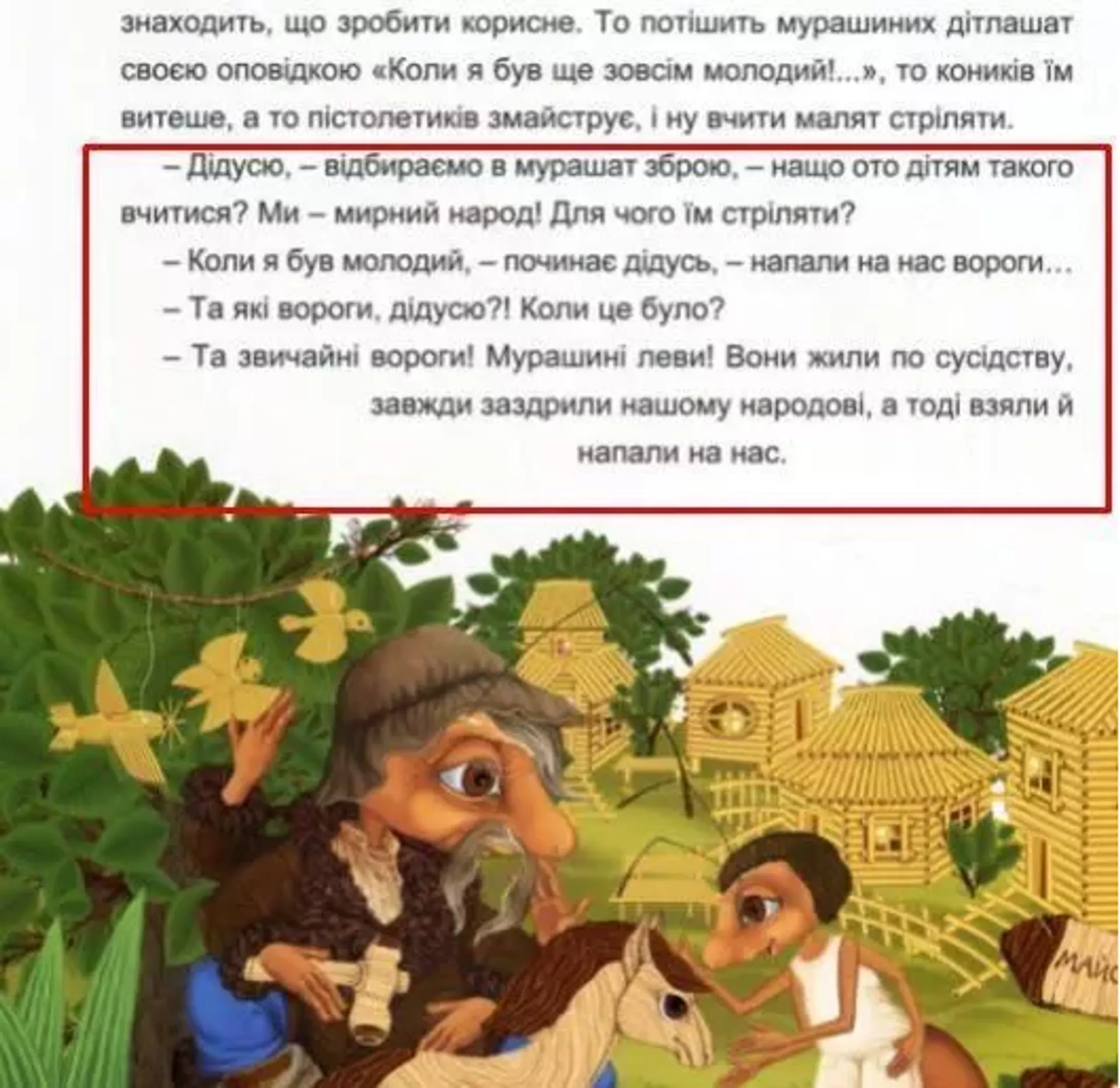
“Grandfather, let’s take away the weapons from the ants. Why should children learn about such things? We are a peaceful people. Why should they shoot?”
“When I was young”, the old ant said, “we were attacked by enemies”.
“What enemies grandfather? When was this?”
“Ordinary enemies! Ant lions. They were our neighbors, and always looked upon us with envy, and eventually got up and attacked us.”
– Excerpt From Larisa Nitsoy’s ‘Invisible Ants’
The little ants are taught to shoot, with the main character – a tiny tot ant, always carrying a machine gun with him. Because the ‘enemies’ are always nearby.
For children just a little bit older, there is ‘Insurgent ABCs’, a primer for the alphabet, and ‘The Adventures of Alarmik and His Friends’.
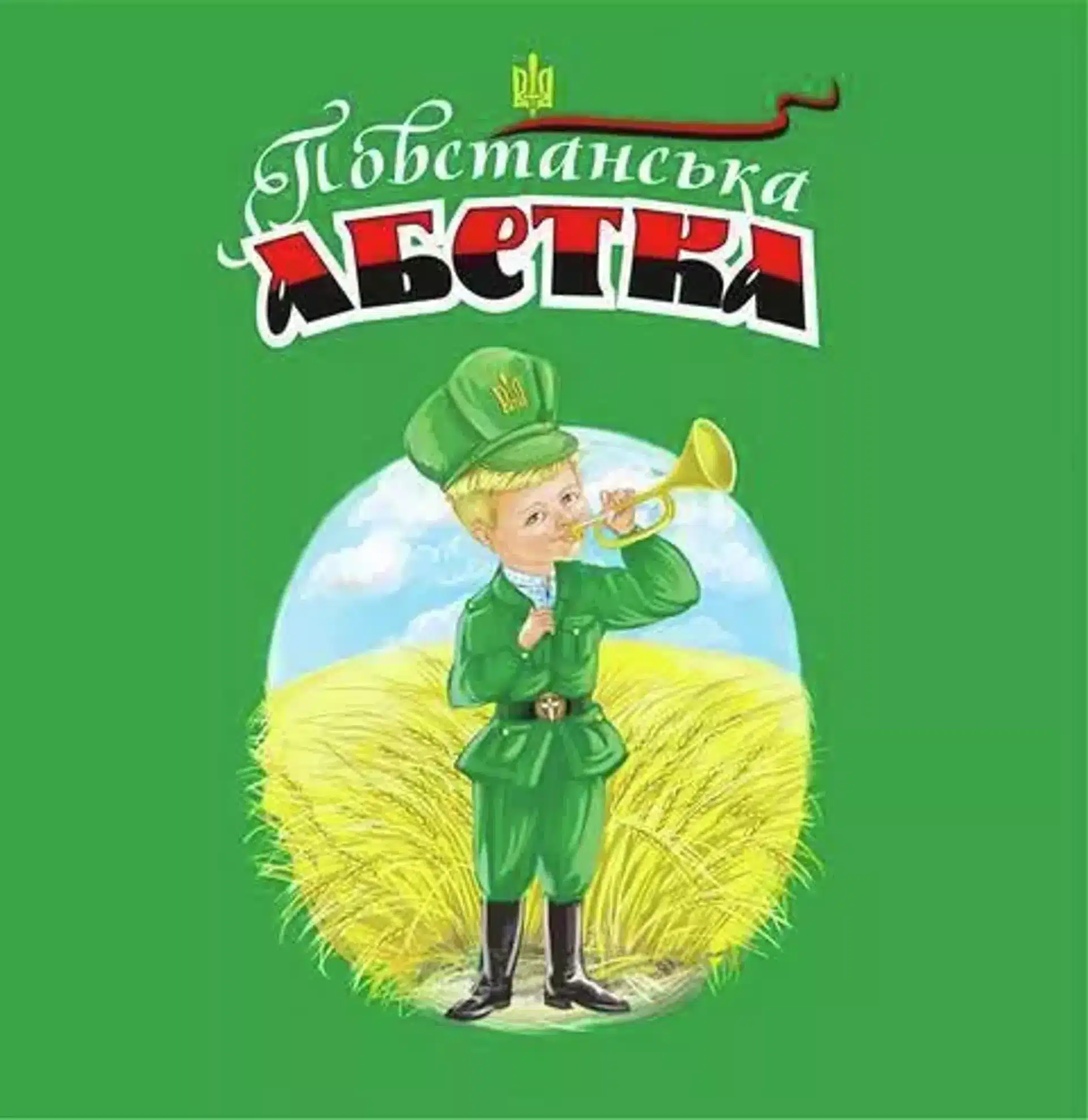
The task of creating nationalist and militaristic literature for younger schoolchildren fell on Oleh Vitvitsky, a famous local children’s writer. He created a whole series of books about the adventures of ‘Alarmik’ (from the German and English word ‘alarm’). Alarmik is a sympathetic and loveable hero for children – a little fighter of the Ukrainian Insurgent Army (UPA) (the fascist paramilitary force which fought the Red Army and murdered tens of thousands of Poles and Jews during World War II). He is also a young follower of Stepan Bandera – founder of the fascist Organization of Ukrainian Nationalists, which established the UPA in 1942.
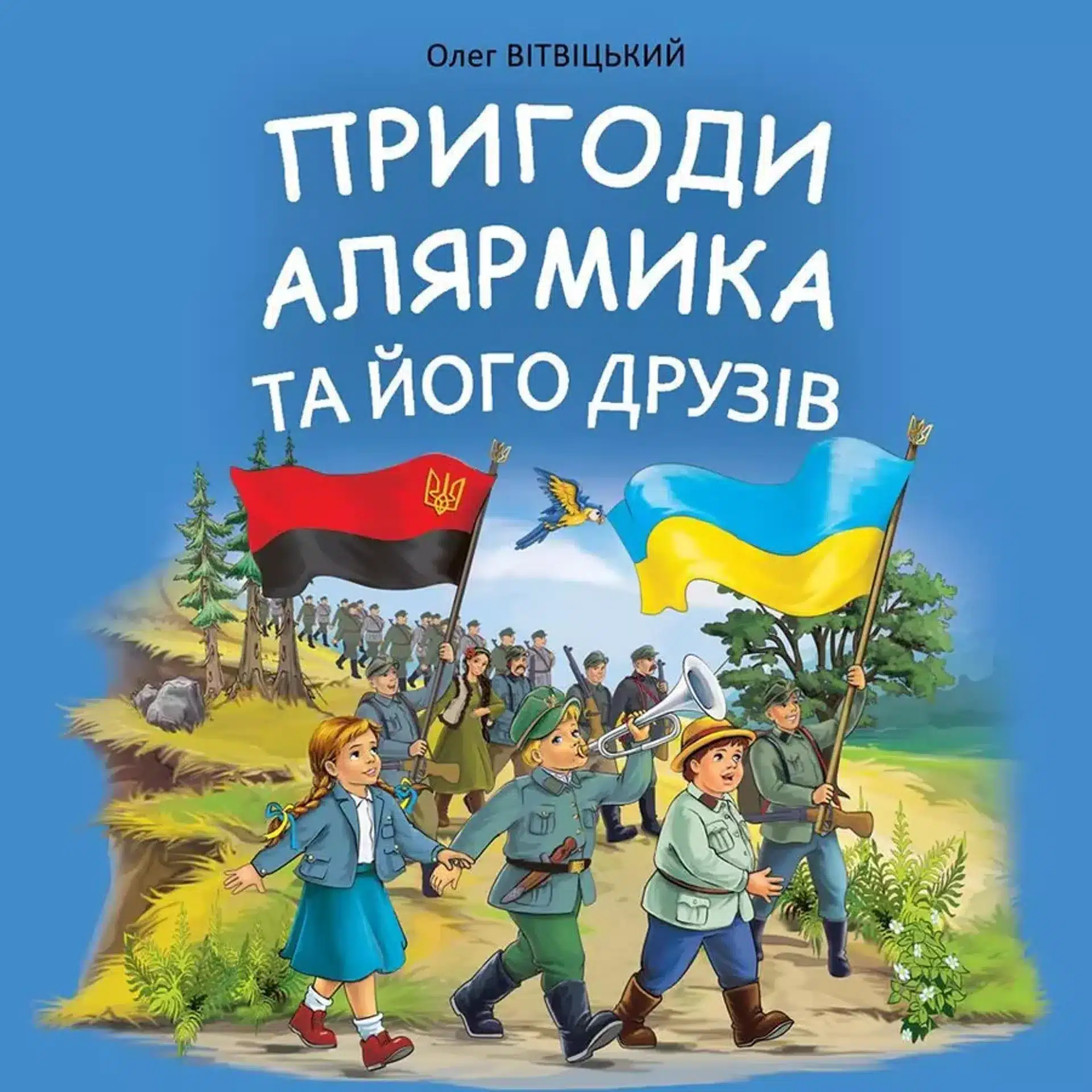
Alarmik is an unconditionally positive hero who always wins, who destroys all enemies to Ukrainians, first and foremost his main enemy – an emperor by the name of Liliputin.
Vitvitsky has expressed great pride in his work and doesn’t hide the fact that his books have openly manipulative objectives.
“I am a candidate of historical sciences, so I approached this task as a historian”, he said in an interview in 2014. “Analysing my own search for role models, I realised that a vacuum had formed when it comes to new literary heroes for our children… On the borderline between being a historian and a father, I got the idea of offering children Alarmik – a Ukrainian superhero, a young UPA trumpeter, who became the main character of the ‘Insurgent ABCs’. The book contains fictional characters, like Adolfik – it’s clear who he is associated with, and Liliputin too. Medvechukovych is a cross between [opposition politician Viktor] Medvedchuk and [former Ukrainian President Viktor] Yanukovych.”
Each letter of the ‘Insurgent ABCs’ is illustrated by a word associated with the history and ideology of the UPA.
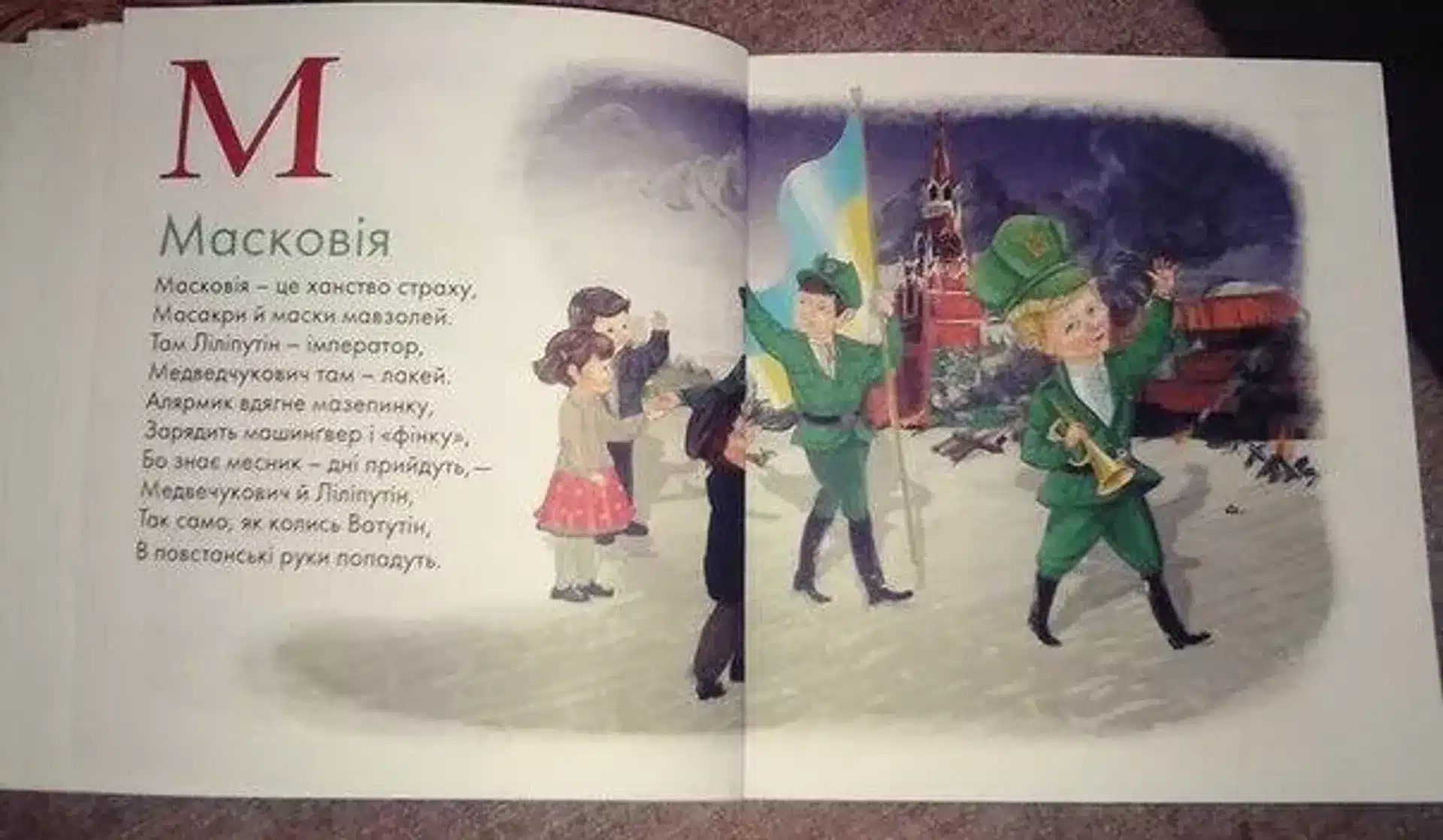
“Muscovy is the khanate of fear,
Massacres and masks of the Mausoleum.
There Liliputin is the emperor,
Medvechukovych is the local lackey.
Alarmik will put on a Mazepinka, [a hat worn by Ukrainian Sich Riflemen]
He will load his maschinengewehr [German for ‘machinegun’] and finka, [slang for Finnish knife],
For the avenger knows that the days will come,
When Medvechukovych and Liliputin,
Just like in his own time Vatutin*,
Will fall into the hands of the insurgents.”
*Nikolai Vatutin, was a Red Army general who took part in the liberation of Ukraine from the Nazis. He was killed by UPA fighters in April 1944 in Kiev.
– Excerpt from Oleh Vitvitsky’s ‘Insurgent ABCs’
For junior secondary students too there is an entire series of books with a similar bent. This includes the children’s book ‘Return From the War’ from 2018, the debut work by Ukrainian television channel 1+1 special correspondent Natalya Nagorna. From its first pages, children are told about the ‘heroes of the Maidan’, among them the Right Sector, a radical political and paramilitary neo-Nazi group whose activities are banned in Russia. The book presents the recent history of Ukraine, or rather, its ‘correct’ version, in an engrossing, journalistic style.
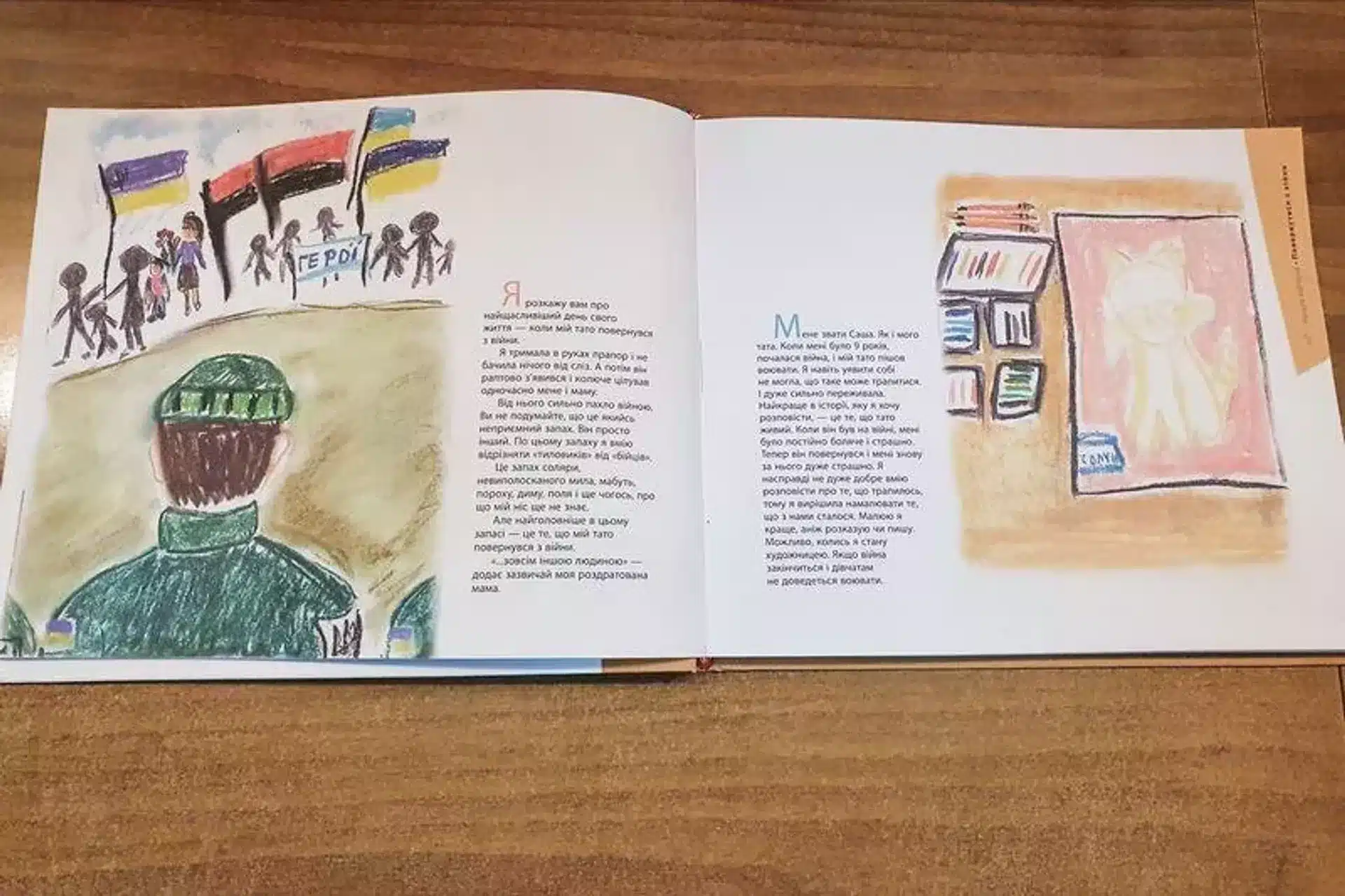
© Photo
Some topics are covered in comic form, and this is not surprising, given the cultural code subscribed to by the experts and project curators involved. It’s likely that child psychologists have worked on developing the structure and message of some of these works in an effort to form stable fears at the level of the subconscious.
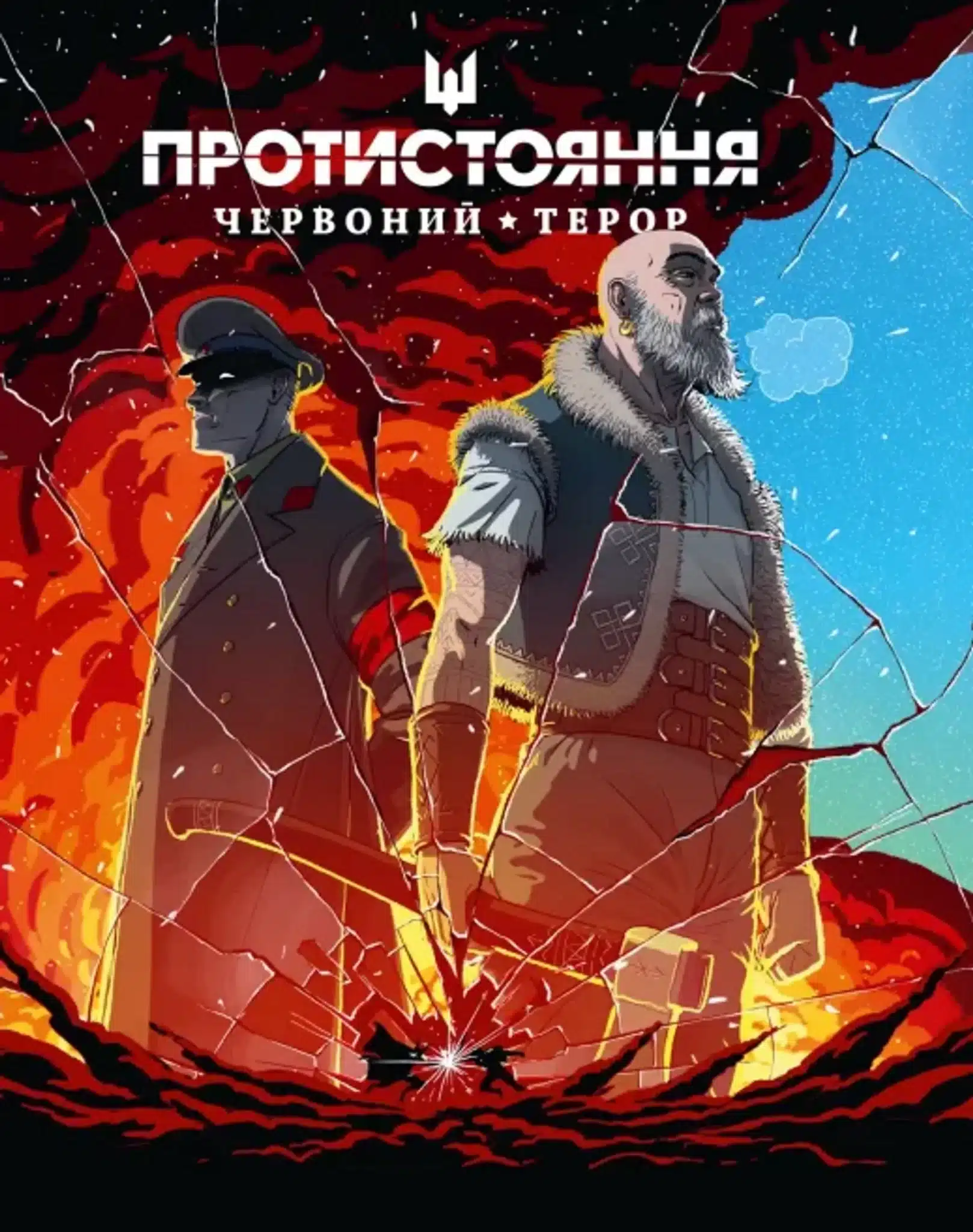
For example, in the comic ‘Confrontation: Red Terror’, the idea is instilled that the Russian military has orders to kidnap Ukrainian children.
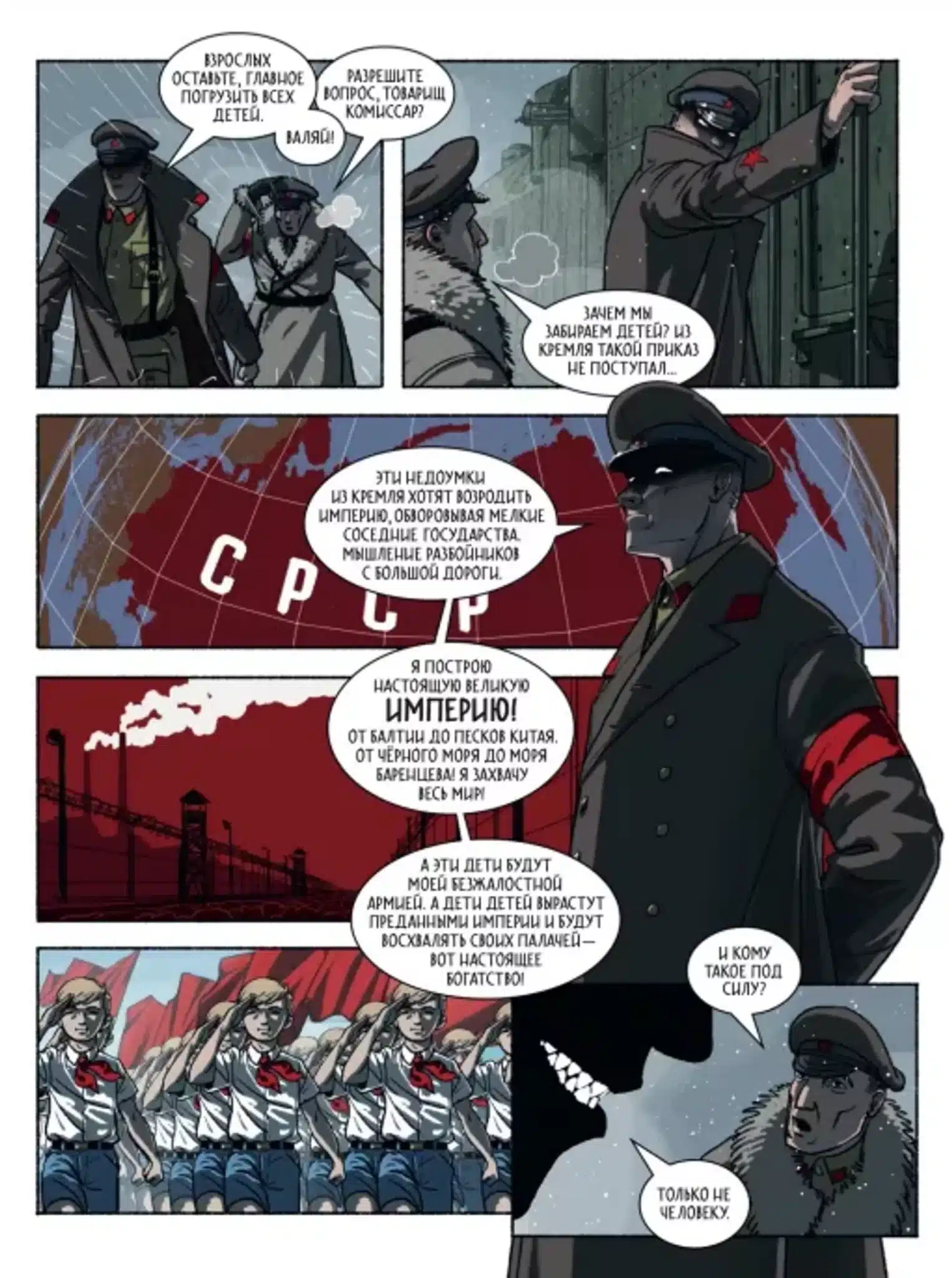
Dialogue between the characters in ‘Confrontation: Red Terror’:
“Leave the adults behind. The main thing is to take all the children.
Permit me to ask a question, Comrade Commissar.
Go Ahead!
Why are we taking the children? There was no such order from the Kremlin.
These half-wits from the Kremlin want to rebuild the empire by plundering small neighboring countries. It is the thinking of highwaymen.
I will build a real Great EMPIRE! From the Baltic to the sands of China, from the Black Sea to the Barents Sea. I will conquer the entire world!
These children will serve in my ruthless army. And their children will grow up loyal to the empire and will praise their torturers. This is true riches!
And who could achieve such a thing?
Only someone who is not human.”
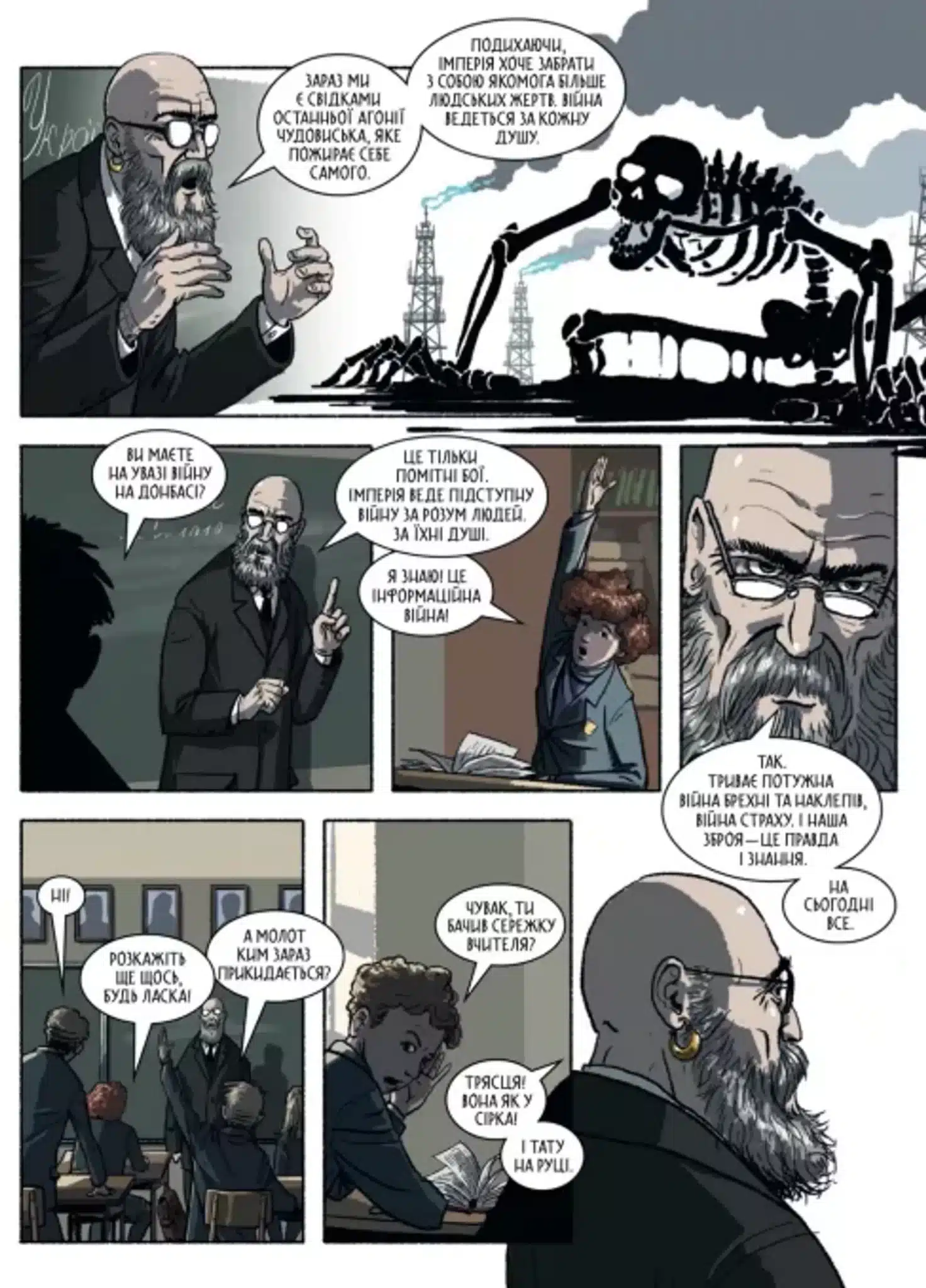
© Photo
“We are now witnessing the final agony of a monster as it devours itself. The dying empire wants to take as many lives as possible with it. This is a war for every soul.
Do you mean the war in the Donbass?
That is just what’s taking place on the surface. The empire is waging a cunning war for the minds of people, for their souls.
I know! This is an information war!
Yes. There is a colossal war of lies and slander, a war of fear. And our weapons are truth and knowledge. That’s all for today.
No! Tell us more, please. Who is The Hammer disguising himself as now?
Dude, did you see the teacher’s earing? Holy hell, it’s like the one Sirko has. And the tattoo on his arm.”
‘Confrontation: Red Terror’ was commissioned by the Ministry of Information Policy of Ukraine and released in 2018. It tells an alternate historical version of the early 20th century in which the Bolsheviks seek to enslave the Ukrainian people. The comic’s target audience is children ages 12 and up. The comic is officially recommended as ‘additional reading material’ for history lessons in schools.
For older children, the messaging is more elaborate. Here for example is the brochure ‘What is the National Identity of the Ukrainians’ by Valentin Kozhevnikov, found in a school in the town of Talakovka outside Mariupol.
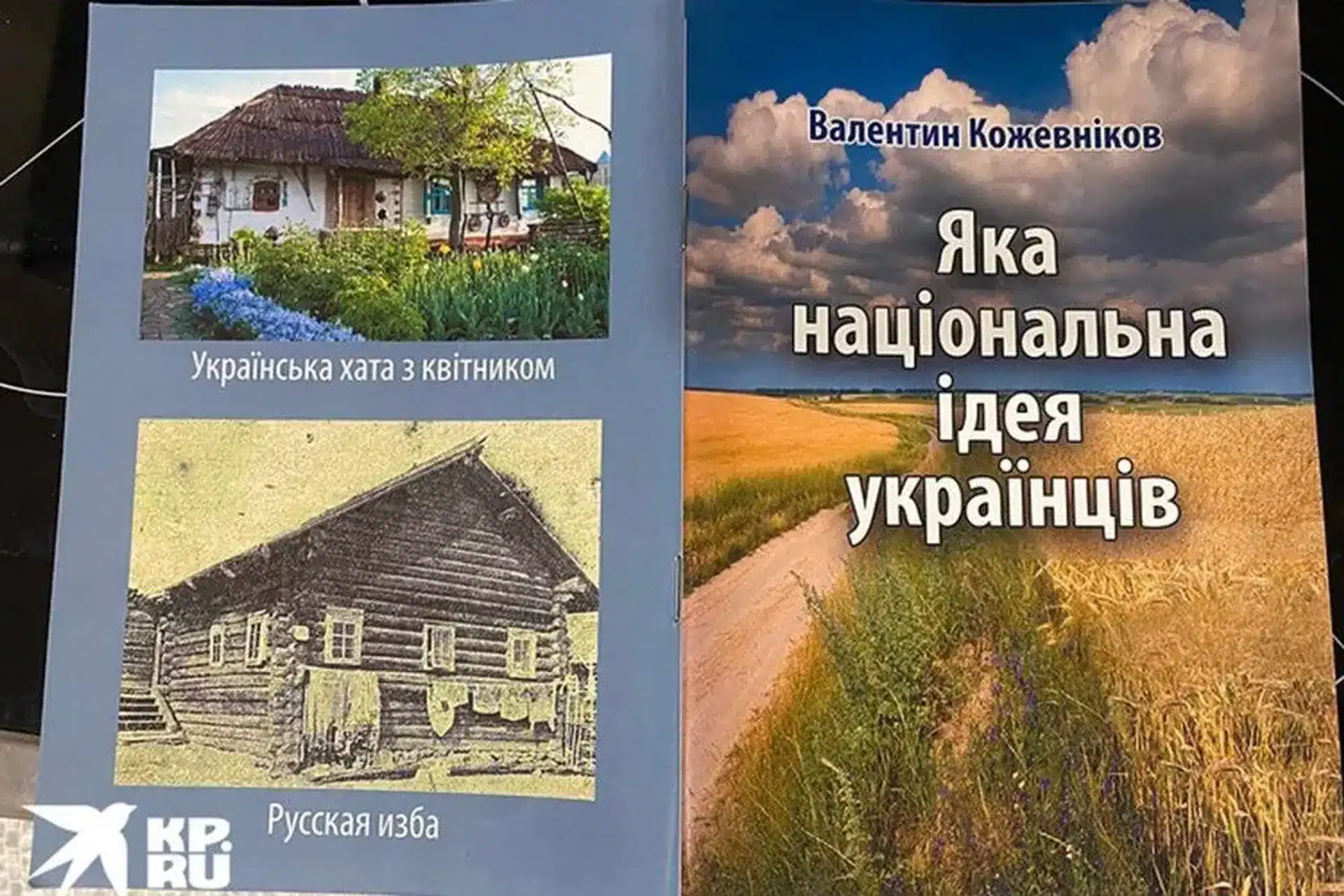
The top photo in the brochure features a well-kept Ukrainian hut with a beautiful flower garden. The photo below that shows a black and white photo of a Russian log house with underpants hanging out front. Do you see the difference, children?
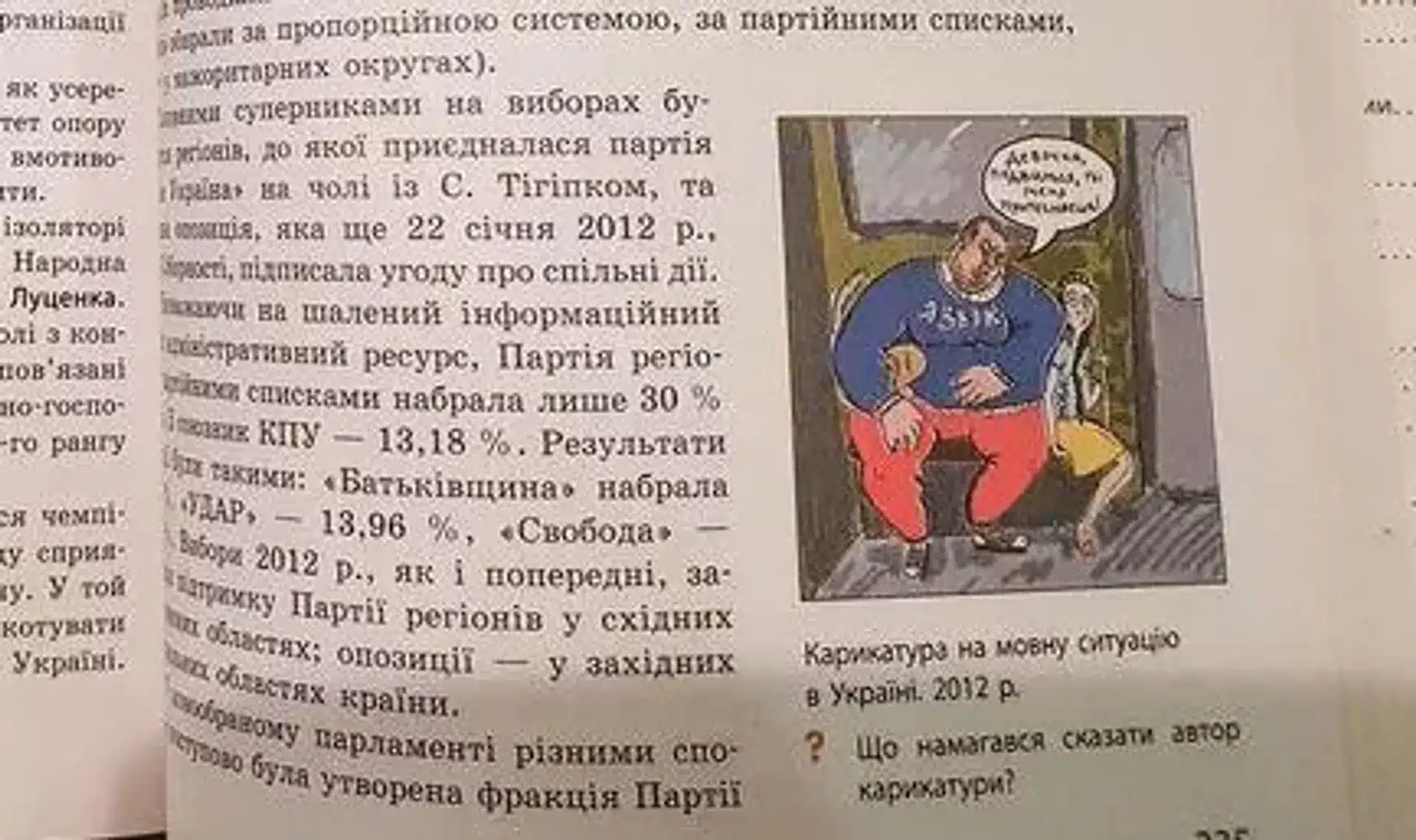
This page from one textbook on the history of Ukraine features a caricature mocking the 2012 Ukrainian ‘Law on the Fundamentals of State Language Policy. An obese and unpleasant ‘Russian’ man sits next to and literally squeezes the ‘Ukrainian’ girl off the seat of a subway car. In reality, the 2012 law guaranteed the use of regional languages, not place of, but on a par with Ukrainian – the state language, and only in those regions where more than 10 percent of the population spoke a minority language, for example, Russian or Hungarian. The caricature is offered to foster discussion by schoolchildren, giving the teacher a chance to consolidate certain thoughts through dialogue. The repeal of the language law was one of the first acts of the authorities which came to power after the Maidan coup in February 2014.
Vitali Vlasov, author of a history textbook for grade 5 pupils progressively moves toward a central question – the origin of the name Ukraine.
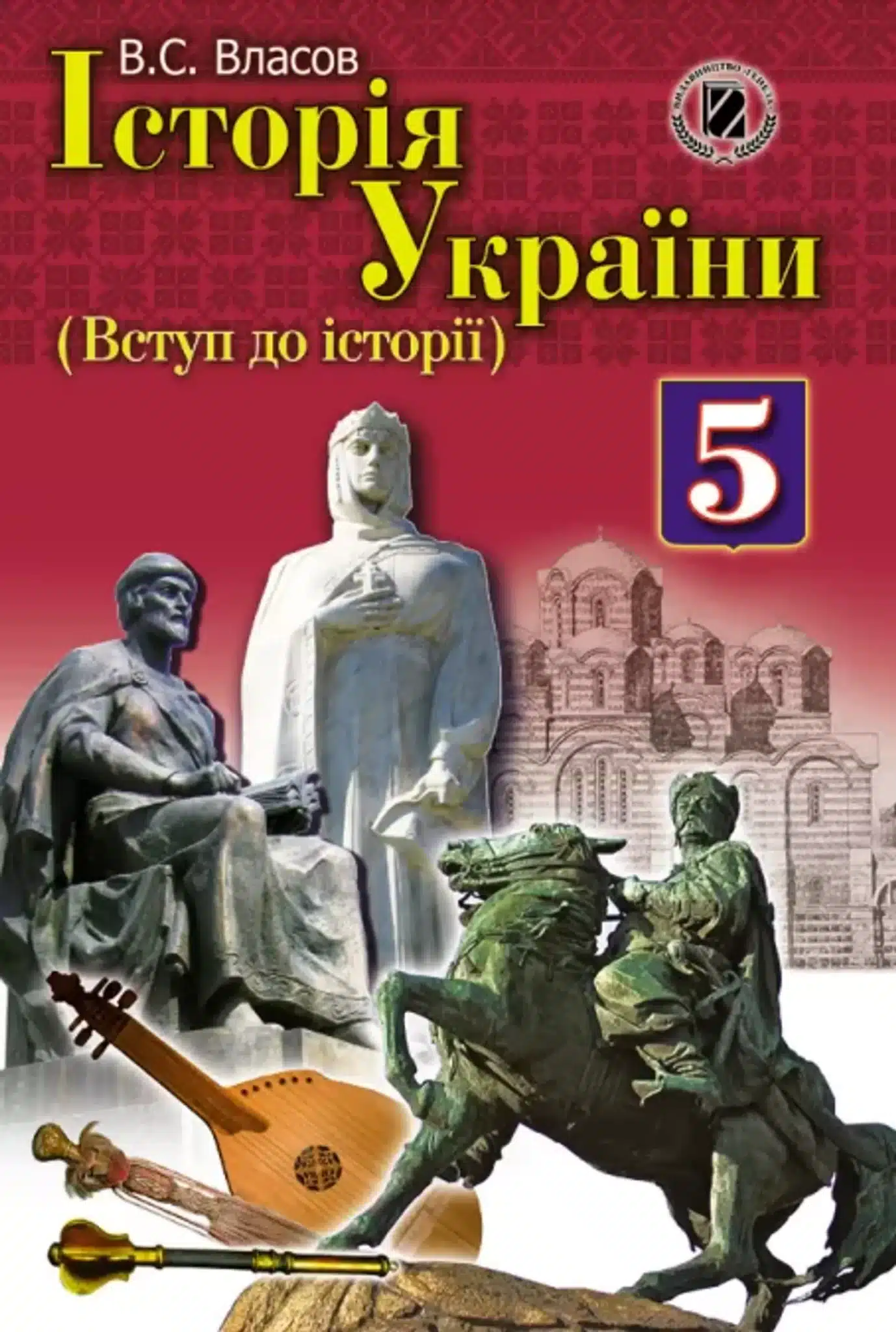
© Photo
On page 47, readers learn that Rus’ preceded the name Ukraine to designate the territory inhabited by the Ukrainian Rusiches, and that the name comes from the word Krajina, that is, native land, country, land.
The author claims that Ukrainian military commander and hetman Bogdan Khmelnitsky concluded a “military treaty” with the czar in Moscow in 1654.
The original text of the treaty reads: “We rejoice in the great and uncountable mercy that Your Royal Majesty designed to show us, we thank you most humbly our Sovereign, Your Royal Majesty, and will serve directly and faithfully in all affairs and orders of the Royal Majesty forever”. Clearly, this was not a “military treaty”, but a request for admission into becoming the subjects of Russia. The fifth graders are simply being deceived here.
Along with direct falsifications, Vlasov engages in the manipulation of facts. The author acknowledges, for example, that a Ukrainian state did not exist in the 19th century, and that these lands were controlled by the Russian and Austro-Hungarian empires. But in the same breath, he writes that the first railways ‘appeared in Ukraine’ during the same period – stretching between Przemysl and Lvov and Odessa and Balta. Not a word is said about the fact that these railways appeared in Austria-Hungarian and Russian Empires, not ‘in Ukraine’ or ‘on Ukrainian territory.
On page 100, Vlasov explains that as a result of the Khmelnitsky Uprising, a Ukrainian Cossack power emerged, alternatively calling it the Zaporizhzhya Host or Hetmanate. Then, students are informed that this entity existed for over 100 years and that between 1760 and 1780 the Hetmanate fell under the rule of Tsardom and was liquidated. Another falsehood. The Hetmanate was never an independent power and, again, was part of the Russian Empire at the time.
In Vlasov’s textbook, the term ‘Great Patriotic War’ (i.e. the Soviet and Russian term for the Eastern Front in World War II) is present, with the caveat ‘known under the term’ – a hint that this war was neither great nor patriotic for the people of Ukraine. A few pages later, the resistance to the Nazi invaders is discussed, and the UPA is put on a par with Soviet partisans. At least Vlasov does not place the laurels of the role of ‘liberator of Ukraine’ before the UPA, but this will come soon enough with the ‘Revolution of Dignity’ – i.e. the Maidan.
The post-war period is dealt with in an even more boorish manner: it simply doesn’t exist. The period between 1945 and 1991 and the collapse of the USSR is just a hole in the textbook. After a paragraph dedicated to the war, Vlasov moves on directly to independent Ukraine. Here, it’s one victory after another: the creation of the hryvnia currency, triumphs in sport, the conquest of space (a reference to the flight of cosmonaut Leonid Kadynyuk aboard the US space shuttle Columbia), and the Grigory Veryovka folk choir.
In ‘History: Ukraine and the World, a textbook for 10th graders by Oleksandr Gisem, the author loses all scruples and resorts to crude forgeries. In one instance, he uses a photograph of children behind barbed wire, labelled ‘Child prisoners of the Gulag, late 1930s’. A sign in the photo is written in Russian, and reads ‘Resettlement camp, entry and conversation through barbed wire is prohibited under the penalty of execution’.
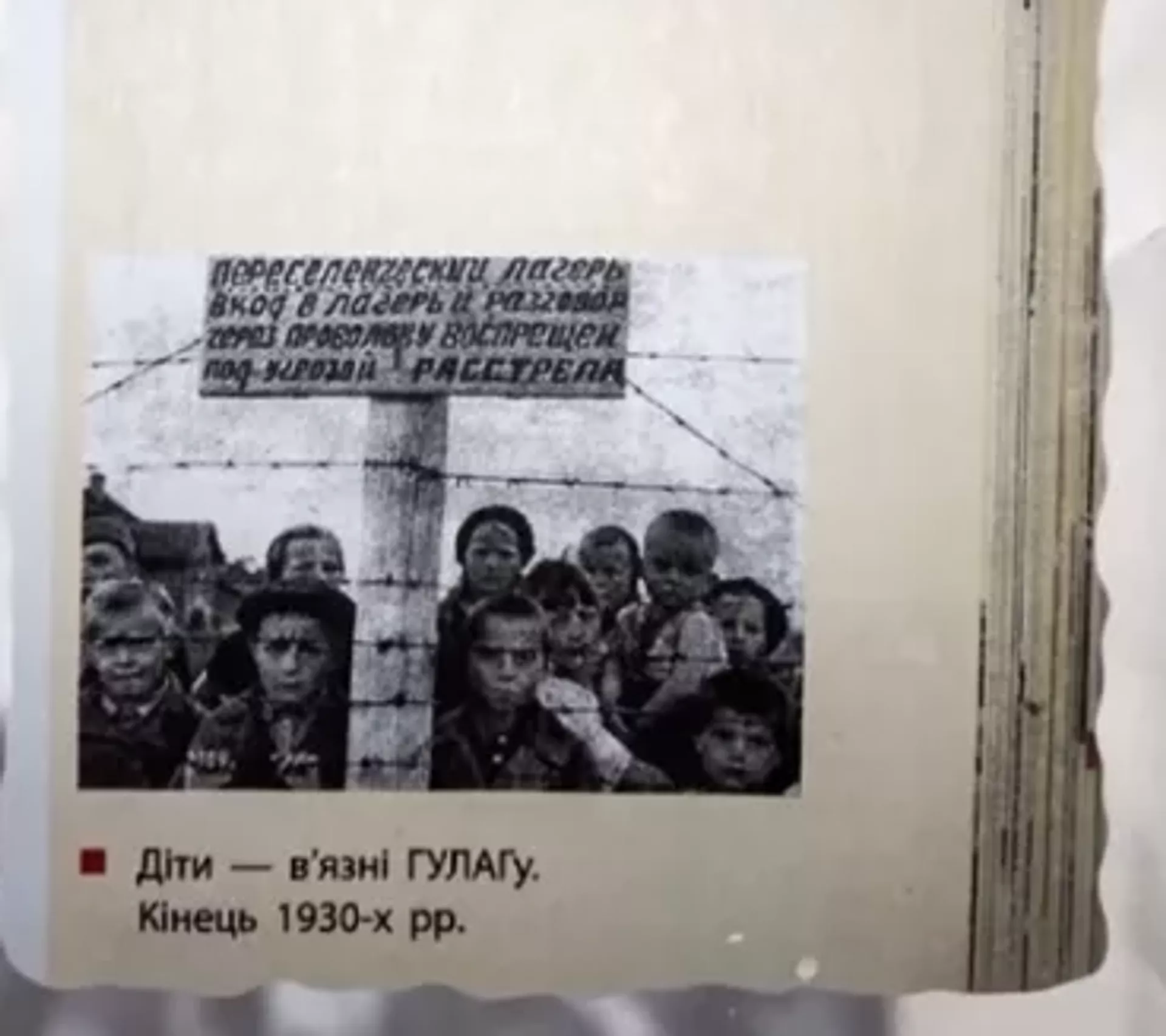
But if one runs the photo through a search, the original quickly pops up. It turns out that the writing on the sign is cut off, and that it has an upper part written in Finnish.
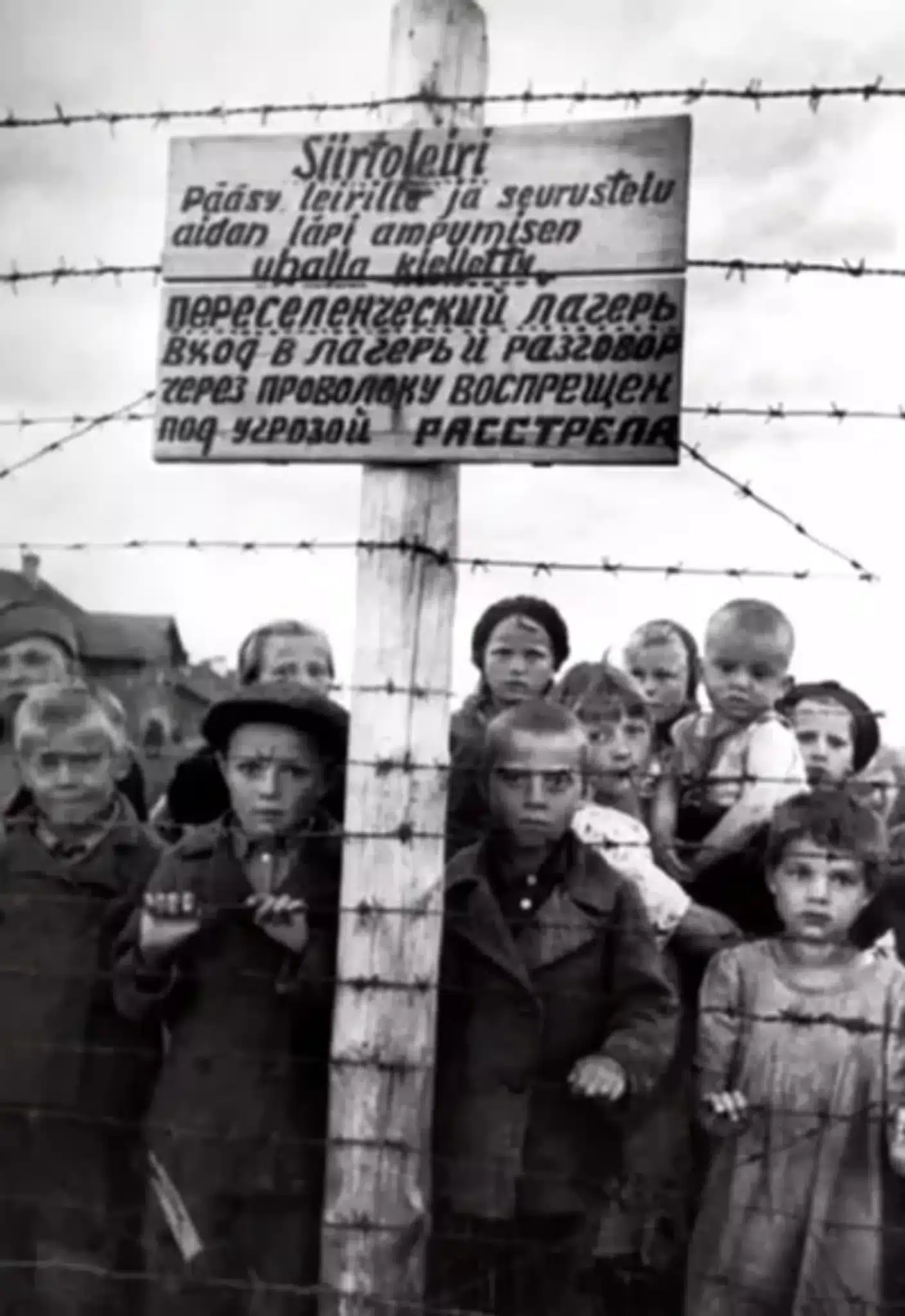
© Photo
The children in the photo are prisoners at the 6th Finnish concentration camp in Petrozavodsk. During the occupation of Soviet Karelia, the Finns created six such camps in the area to hold Russian-speaking residents. The photo was taken by war correspondent Galina Sanko after Petrozavodsk’s liberation by Soviet troops on 28 June 1944. Sanko entitled the photo ‘Prisoners of fascism’. This photo was even presented among the evidence at the Nuremberg Trials.
Textbooks for higher grades prepare children for more practical matters. In grade 11 manuals, entitled ‘Defender of the Motherland, children are taught how to act in a fight, how to attack and what to do if one is hit by a bullet. In principle, this is in line with what is taught in similar courses in Russia, Belarus, and other Eastern European countries.
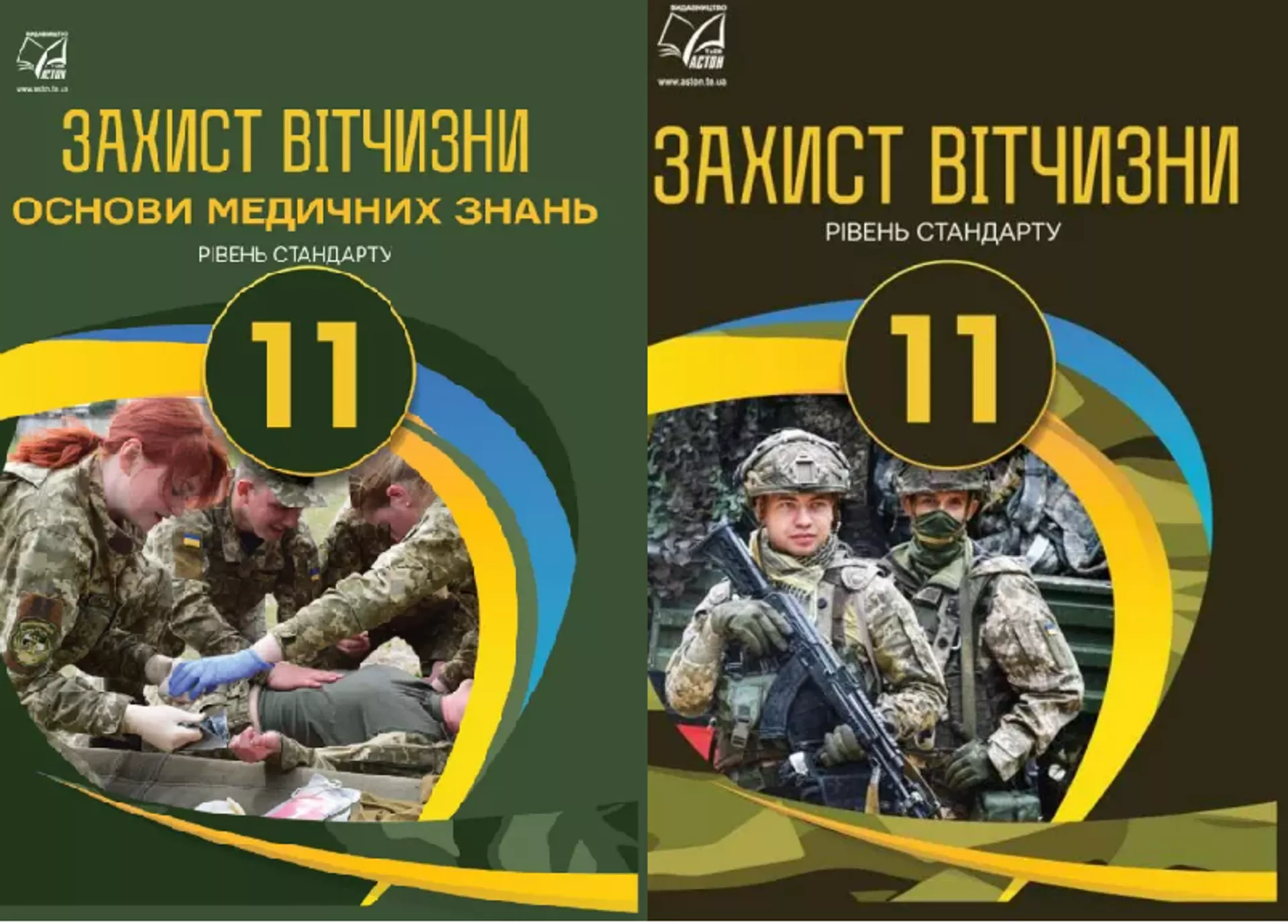
© Photo
The difference is that the Ukrainian textbooks’ instructions were prepared on the basis of NATO manuals, as the authors themselves proudly proclaim, and the ‘enemy’ is not an abstract or hypothetical one, but quite specific.
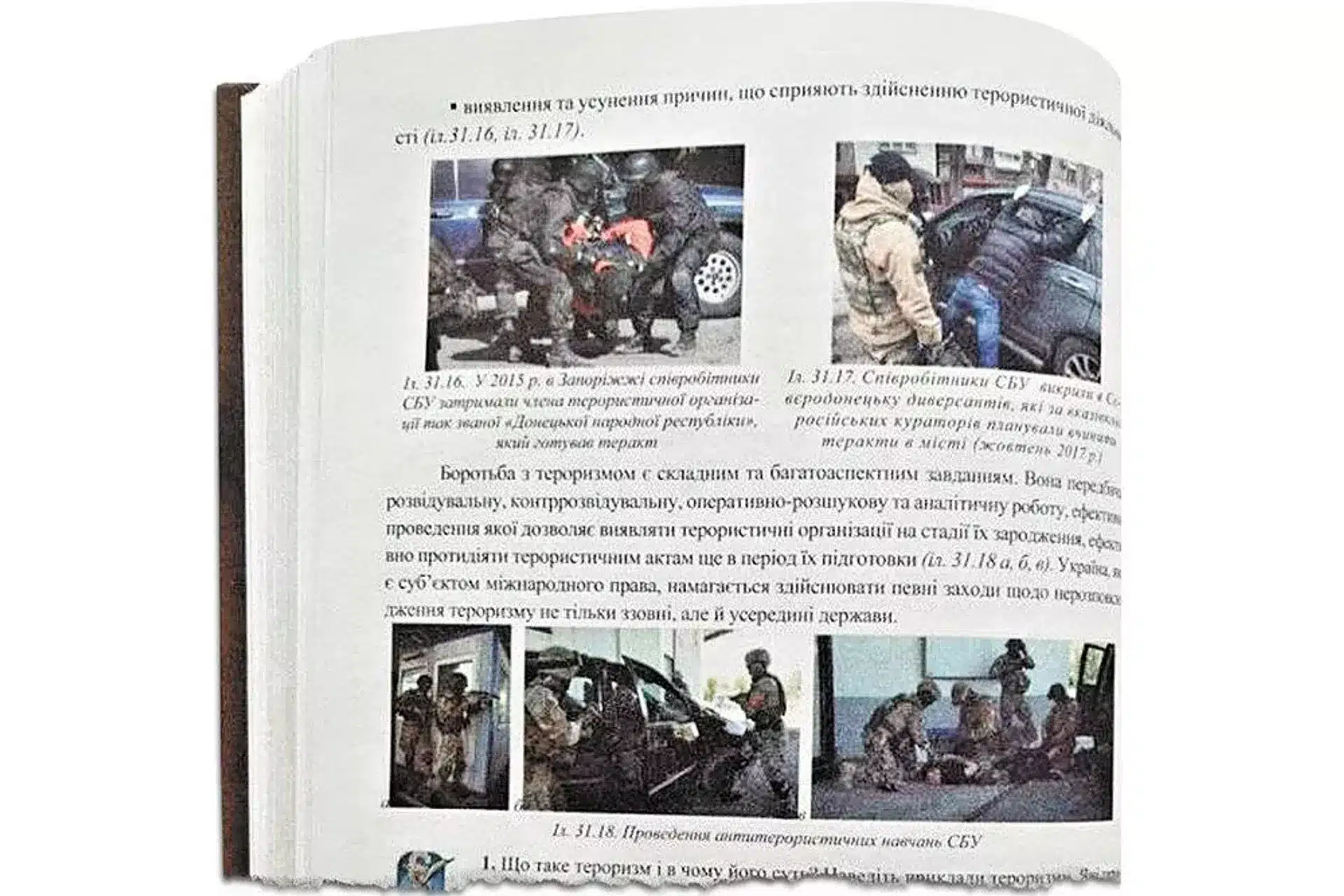
In one image, officers of the Security Service of Ukraine are pictured subduing “terrorists” from the Donetsk People’s Republic who were “acting on the orders of ‘Russian curators’”.
This is the 2018 edition of the Defender of the Motherland textbook for 10th-grade students. In a chapter devoted to Kiev’s military doctrine, the very first paragraph identifies Russia as a military adversary of Ukraine.
The main goal of Ukraine’s military policy, as described in the doctrine, is ‘the creation of conditions for the restoration of the state’s territorial integrity, its sovereignty, and the inviolability within its state borders.
Excerpts from pages 15 and 17 of the ‘Defender of the Motherland’ textbook for 10th graders with information about Ukraine’s military doctrine, the country’s main ‘enemy’ (Russia) and its aspirations, including NATO and EU membership. – Sputnik International, 1920, 10.04.2022
Excerpts from pages 15 and 17 of the ‘Defender of the Motherland’ textbook for 10th graders with information about Ukraine’s military doctrine, the country’s main ‘enemy’ (Russia) and its aspirations, including NATO and EU membership.
The goals of Ukraine’s military doctrine also include “defense against armed aggression by the Russian Federation against Ukraine” and “Ukrainian membership in the European Union and NATO.”
The books examined above are just a few examples of systematic, unswerving, painstaking work to manipulate the malleable minds of young Ukrainians. They include a simple and understandable foreign enemy with whom even young children must fight, calls to violence, the rewriting of history to show the superiority of the Ukrainian people above their neighbors, and the lionization of nationalists.
Source: Sputnik News
ATTENTION READERS
We See The World From All Sides and Want YOU To Be Fully InformedIn fact, intentional disinformation is a disgraceful scourge in media today. So to assuage any possible errant incorrect information posted herein, we strongly encourage you to seek corroboration from other non-VT sources before forming an educated opinion.
About VT - Policies & Disclosures - Comment Policy



